 |

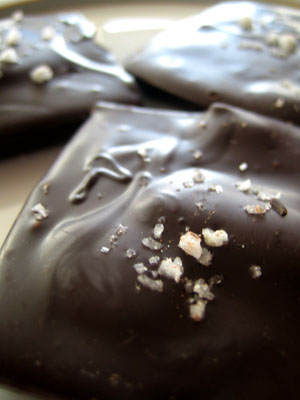 |
| Poco Dolce’s bittersweet chocolate “tiles” with sea salt are a
taste sensation that will leave you craving more. Photos of
Poco Dolce chocolate by Melody Lan. |
| WHAT IT IS: Bittersweet chocolate “tiles,” 2-inch squares, sprinkled with grey sea salt that brings out flavor accents in the chocolate without making it “salty.” |
| WHY IT’S DIFFERENT: Other chocolatiers have combined chocolate and sea salt on bars (as well as on bonbons and caramels); the concept here is bite-size portions: plain, spicy Aztec, or with almonds, coconut and almonds, crystallized ginger or toffee. |
| WHY WE LOVE IT: Simplicity of concept and complexity of tastes. It’s hard to think of a chocolate-sophisticate who wouldn’t appreciate these. |
| PURCHASE AT: PocoDolce.com. |
|
|
 |

Poco Dolce Chocolates:
Worth Their Salt
CAPSULE REPORT: Poco Dolce chocolate tiles are a welcome addition to the artisan chocolate pantheon. Marrying 63 percent cacao Guittard chocolate with grey Celtic sea salt crystals from the salt marshes of Brittany, a kind of chocolate magic transpires. You don’t get salty chocolate. Salt, which enhances the taste of everything from meat to apples, elevates the bittersweet chocolate flavors like a pas de deux between Nureyev and Fonteyn.
The tiles are available plain; in an assortment that includes Almond, Aztec Chile, Burnt Caramel Toffee and Ginger; and new Coconut Almond. These 2-inch squares will have you captivated: what sounds simple is delightfully complex. One tile is satisfying anytime, and perfect with afternoon coffee or after-dinner espresso.
You can purchase Poco Dolce online and beg your local specialty shop to bring them in, so you need never run out. Read the full review below, including an overview of sea salt.
- For more of our favorite artisanal chocolates in THE NIBBLE online magazine, click here.
- For the table of contents of the June issue of THE NIBBLE online magazine, plus the back issues archive, click here.
|
THE NIBBLE does not sell the food products we review or receive fees from manufacturers for recommending them. Our recommendations are based purely on our opinion, after tasting thousands of products each year, that they represent the best in their categories. |
Hang With The Great Chocolatiers
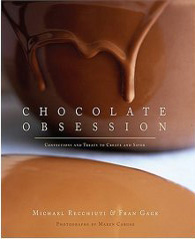 |
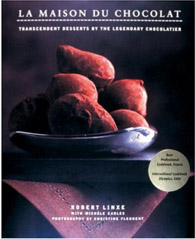 |
 |
Chocolate Obsession: Confections and Treats to Create and Savor,
by Michael Recchiuti. “The Picasso of Chocolatiers” has made it possible for even the amateur to achieve his artistry. Owner of the famed artisanal chocolate company in San Francisco, Recchiuti divulges his professional secrets and techniques, allowing home cooks to reproduce his exquisite confections in their own kitchens. Click here for more information or to purchase. |
La Maison du Chocolat: Transcendent Desserts by the Legendary Chocolatier, by Robert Linxe. The Parisian chocolatier and patissier—he’s been called the sorcerer of ganache—shares 65 recipes, from candies and cakes to creams, mousses and soufflés. Click here for more information or to purchase.
See more of our favorite books at the end of the review. |
Dessert Circus: Extraordinary Desserts You Can Make At Home,
by Jacques Torres. From chocolate-covered almonds and peanut butter cups to elaborate pastries, each recipe is rated for its level of difficulty so you can start with desserts that match your level of experience and work your way up. Every recipe has step-by-step photographs and a color photograph of the finished dessert. Click here for more information or to purchase. |
Worth Their Salt : Poco Dolce Chocolate Tiles
We know people who crave sweet and salty. Give them a bowl of M&Ms mixed with salty peanuts and they’re happy campers. Send them a box of Poco Dolce sea salt-accented chocolate tiles and they’re ready to buy the camp.
Even for those like us who have no known sweet and salty cravings, Poco Dolce, which means “not too sweet” in Italian, is a revelation in tastes. Salt is a known flavor-enhancer: it perks up just about any food and finds its way into most recipes, even cakes and cookies. So imagine what happens when you take some of the finest salt in the world—in this case grey sea salt raked by hand from salt beds off the coast of Brittany—and add it to the bittersweet chocolate of one of the world’s finest chocolatiers, Guittard. That’s what Kathy Wiley does, along with a bit of alchemy; because in her hands, this seemingly simple recipe becomes golden. The sensual mouth feel, the crunch of the crisp, flat tile, just the right balance between salty and sweet, with a long finish on the palate...these chocolates are a phenomenon (perhaps even more so because Wiley is a self-taught chocolatier, with prior careers in IT and photography).
On The Menu: Tile Varieties
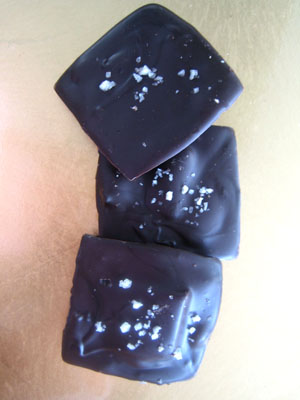 After the original Poco Dolce tiles—solid chocolate with sea salt—met with acclaim among food circles of her San Francisco home base, Wiley developed a separate “flavor assortment”: After the original Poco Dolce tiles—solid chocolate with sea salt—met with acclaim among food circles of her San Francisco home base, Wiley developed a separate “flavor assortment”:
- Almond, with especially delicious, double-roasted almonds
- Aztec Chile, with chile powder, cinnamon and toasted pumpkin seeds
- Burnt Caramel Toffee, with large chunks of superb almond toffee (tiles of chocolate-covered toffee are sold separately)
- Ginger, with pieces of crystallized ginger
A new flavor, Coconut Almond, inspired by her handmade rochers, is just making its debut. Anyone who loves Almond Joy will want to buy several boxes of these.
Each tile is dusted with coarse grey sea salt, creating a beautiful aesthetic: large, sparkling grains of salt against glossy dark brown chocolate. They make an impressive presentation alone or on a petit fours plate.
WHAT’S THE DIFFERENCE BETWEEN SEA SALT & REGULAR SALT?
Between grey sea salt, sel gris, Fleur de Sel and all of the other sea salts?
See them all with beautiful photos in our Salt Glossary. |
Each of the flavors is magnificent. If you think you might not like crystallized ginger or chile in your chocolate, open up your palate and give them a chance. As with salted chocolate in general, after the first waltz, you will probably be converted to the dance. If you’re not convinced by our say-so, try the test below.
|
Both Aztec Chile and Ginger have a bit of a kick, adding a level of excitement to something that, in its original form and in the non-spicy Almond and Burnt Caramel Toffee favors, is already molto eccitante.
A word about the Aztec Chile flavor: for a decade or so, a number of artisan chocolatiers have been making “Aztec” chocolate bars and cocoa powders, using spices like chili, chipotle and cinnamon, reminiscent of the spices used by the Aztecs to flavor the original xocoatl (sho-KWA-til), the unsweetened, tepid spiced beverage that was enjoyed by the privileged classes of the ancient Mesoamerican empire. We buy Aztec bars whenever we see them and with Wiley’s golden touch—the added pumpkin seeds—Poco Dolce’s Aztec may be the best yet.
At left: One of Wiley’s delicious rochers, coconut and almond enrobed in bittersweet chocolate. It was a winner in flavor, but not as easy to ship. She has since converted it into the Coconut Almond tile shape.
|
Sweet & Salty: Taste Test
The sweet-salty pairing is one of nature’s perfect flavor combinations. You can try it for yourself with any piece of chocolate and any table salt.
- With a cleansed palate, place a small piece of plain chocolate on the tip of your tongue. As it melts, pay close attention to the overall strength of flavor, the degree of sweetness or bitterness, the smoothness or harshness of taste, and any other flavors you may be able to distinguish.
- After the flavor dissipates, take a sip or two of water to re-cleanse your palate. Now, sprinkle some salt onto the tip of your finger and touch the salt to your tongue just before tasting the second piece of chocolate. Again, note everything you are able to taste, particularly the overall strength of flavor and any subtleties you may not have noticed before.
Most people are amazed to find out what the addition of that pinch of salt does for their appreciation of chocolate. It truly seems to waken the taste buds, accentuating all of the chocolate’s flavors, particularly those that are more subtle.
Back At The Chocolatier’s
Of course, it’s not so simple as to sprinkle sea salt on your chocolate bars. With artisanal chocolate, the whole is greater than the sum of the parts. In other words, buy the Poco Dolce tiles.
Begun in 2003 in San Francisco, Poco Dolce remains something of a cult secret. Amazingly for a chocolate this special, it is carried only by boutique food stores in California and departments of specialty stores like Gump’s, plus outposts in Boston, Chicago and Houston.
But this is a secret that should not be kept. A small box of eight tiles is lovely token of appreciation for someone who loves fine chocolate. Each tile is packaged in a vellum envelope so the chocolates can be dispensed individually—to helpful colleagues, on guest pillows, to anyone who needs something un poco dolce.
But don’t get the small size for your own personal chocolate consumption—you’ll be online to order more by the end of the week.
—Karen Hochman
Update August 2007: Kathy Wiley continues to produce wonderful new products—more flavors of tiles (the Mint is amazing) and the best torrone we’ve ever tasted. There’s also a new bonbon collection we haven’t yet tried, but we can’t believe that it is anything less than first-rate.
FORWARD THIS NIBBLE to anyone who likes great chocolate.
POCO DOLCE
Bittersweet Chocolate Tiles With Sea Salt
- Bittersweet Tiles Topped With
Grey Sea Salt — Solo, Assorted (see
flavors below)
or Coconut Almond
8 Pieces
$16.00
16 Pieces
$32.00
- Assorted Flavors
Flavors
Include:
Aztec Chile (Cinnamon, Chile, Toasted
Pumpkin Seeds)
Burnt Caramel Toffee
Crystallized Ginger
Double Roasted Almond
Hazelnut
Mint Toffee
Sesame Toffee
- Burnt Caramel Toffee (No Salt)
16 Pieces
$32.00
Shop online at PocoDolce.com
or telephone 1.415.255.1443
weekdays from 10 a.m. to 5 p.m.
Pacific Time.
For a retail store locator, click here. |
 |
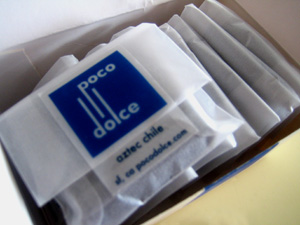
Boxes are available plain or assorted. Small box of 8 pieces,
above, has tiles in vellum envelopes. Large box, below,
presents tiles in a molded ballotin.
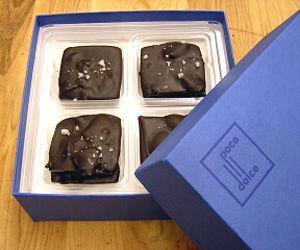
|
Read about some of our other
favorite sweets:
|
|
About Sea Salt
A Brief History Of Salt
What seems like such an inexpensive commodity has been used since pre-historic times as currency, medicine and an enhancer and preservative of food. In cooking, salt enlivens the 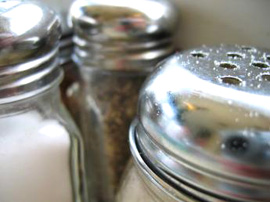 taste of food, intensifying and balancing flavors. Salt has long been used in pickling and in curing vegetables, meats, fish and cheese. Salt has played a prominent role in religious ritual in many cultures, symbolizing purity. There are more than 30 references to salt in the Bible, from expressions like “salt of the earth” to Lot’s wife (although given what we now know to be the expense of salt in earlier times, she was turned into a pillar of extreme value). Salt is also an essential element for the living: life itself would be impossible without it, since the human body requires salt in order to function properly. (For instance, that thousands of Napoleon’s troops died during his retreat from Moscow is attributed to their wounds not healing due to a lack of salt.) And salt is also used in some 14,000 commercial applications, from manufacturing pulp and paper to setting dyes in textiles and fabric, producing soaps and detergents to making icy roads safe. taste of food, intensifying and balancing flavors. Salt has long been used in pickling and in curing vegetables, meats, fish and cheese. Salt has played a prominent role in religious ritual in many cultures, symbolizing purity. There are more than 30 references to salt in the Bible, from expressions like “salt of the earth” to Lot’s wife (although given what we now know to be the expense of salt in earlier times, she was turned into a pillar of extreme value). Salt is also an essential element for the living: life itself would be impossible without it, since the human body requires salt in order to function properly. (For instance, that thousands of Napoleon’s troops died during his retreat from Moscow is attributed to their wounds not healing due to a lack of salt.) And salt is also used in some 14,000 commercial applications, from manufacturing pulp and paper to setting dyes in textiles and fabric, producing soaps and detergents to making icy roads safe.
- Salt was in general use long before recorded time. Its use in pickling predates the 5000-year written Chinese history. Around 2,700 B.C. in China, the earliest known treatise on pharmacology, the Peng-Tzao-Kan-Mu, devoted a major portion to a discussion of more than 40 kinds of salt. Profits from the sale of salt financed the Great Wall. More “recently,” in 1450 B.C., Egyptian art depicts salt-making (ancient Egyptians also used salt for mummification). By 200 B.C., people discovered that adding salt to food kept it from spoiling.
- The ancient Chinese used salt to make a fermented fish sauce. So did the ancient Romans: garum was the Roman equivalent of catsup, a condiment that was used on nearly everything. Royal purple dye was discovered by accident when a garum-maker tried to cook a particular variety of shellfish in the sauce. Reacting with the salt, the shellfish exuded the reddish-purple dye.
- Since currencies in different countries have always differed, salt was an international currency: it was an important trading commodity carried by explorers. Greece, involved in a far-reaching slave trade, exchanged salt for slaves, giving rise to the expression, “not worth his salt.”
- Special salt rations given to Roman soldiers along with their wages were known as salarium argentum, the term from which our word “salary” is derived. As an essential ingredient in food, the Latin word “sal” found its way into salsa and salami.
- Merchants in 12th century Timbuktu valued salt as highly as books and gold. In Venice, whose economic strength was not just as a seaport but as a major salt-producer, the immense salt evaporation pans were referred to colloquially as “the Seven Seas.” The phrase “sailing the Seven Seas” derived from the challenge of navigating one’s craft among the bars that enclosed these evaporation ponds.
- Salt was traditionally expensive, and thus used to bestow social standing. In Medieval and Renaissance European kingdoms, salt cellars would be placed on the table within reach of those deemed worthy. At any noble table, to be seated “below the salt” was to be seen as unworthy of access to such luxury seasoning.
- Throughout history, the necessity of salt has subjected it to governmental monopoly and special taxes. Salt taxes long supported British monarchs; thousands of Brits were imprisoned for smuggling salt. French kings developed a salt monopoly by selling exclusive rights to produce it to a favored few, who exploited that right to the point where the scarcity of salt was a major cause of the French Revolution.
- Americans have been fortunate to have had a plentiful natural salt supply that has not been appropriated for the privileged or taxed. It is one of our least expensive necessities; although in times of shortage, like the Civil War, the Union army was quick to blow up Confederate saltworks to further starve the South, and profiteers (including the founders of the
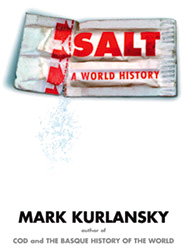 McIlhenny Company, makers of Tabasco®, who owned brine wells in Louisiana) used the shortages to their advantage. McIlhenny Company, makers of Tabasco®, who owned brine wells in Louisiana) used the shortages to their advantage.
- As you’ll read in the final section, salt in the 21st century means a steady supply of deliciously flavored sea salts from all over the world. The basic necessity has gone gourmet.
For more information, read the definitive book on the topic, Salt: A World History, by Mark Kurlansky (photo at right). Combining the historical with the contemporary, the practical with the whimsical, this is a delightful treatise on salt.
The Chemistry of Salt
Sodium chloride, or common table salt, is the chemical compound NaCl—one sodium ion bound to one chlorine ion (chemically, it is 60.663 percent elemental chlorine [Cl] and 39.337 percent 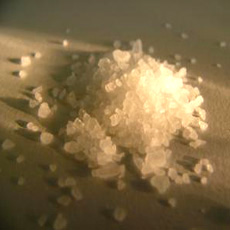 sodium [Na]). Saltiness is a taste produced by the presence of sodium chloride (and to a lesser degree other salts). The ions of salt, especially sodium, can pass directly through ion channels in the tongue. sodium [Na]). Saltiness is a taste produced by the presence of sodium chloride (and to a lesser degree other salts). The ions of salt, especially sodium, can pass directly through ion channels in the tongue.
In chemical terms, salt is one of the most basic molecules on earth. It’s also one of the most plentiful: it has been estimated that salt deposits under the state of Kansas alone could supply the entire world’s salt needs for the next 250,000 years. Salt occurs naturally in many parts of the world as the mineral halite (rock salt) and as mixed evaporites in salt lakes. Underground salt deposits are found in both bedded sedimentary layers and domal deposits (hence salt mines). Some salt is on the surface, the dried-up residue of ancient seas (like the famed Bonneville Salt Flats in Utah). Seawater contains an inexhaustible supply of salt (salt represents about 77 percent of the Total Dissolved Solids in the water).
Sodium chloride crystals are cubic in form—the salt crystal is often used as an example of crystalline structure. It varies in color from colorless, when pure, to white, grey or brownish, depending on what trace minerals are in the salt deposits...as we’ll see in the next section.
Information from the Salt Institute and Cargill Salt.
Splendid Sea Salts
Growing up, most of us were familiar with table salt and perhaps kosher salt for cooking (margarita salt is simply a coarse grind of salt, like kosher salt). If you made ice cream at home with an older-style machine, you used rock salt. Ten years ago, few people in America beyond French chefs had heard of sea salt; those who did were educated though European travel or French cooking.
Today, sea salt is perhaps one of the biggest national gourmet obsessions since balsamic vinegar. Led by a new generation of American chefs who have been using it in dishes sweet and savory and as a garnish on everything from heirloom tomatoes to desserts and petit fours (read our article on salt caramels), it’s a logical evolution. After all, the classic margarita juxtaposes sweet Triple Sec with a salty rim; and fruity margaritas add that much more sugar to contrast with the salt.
These days, a restaurant worth its salt will have a cellar of sea salt on the table: no 20th century salt shaker will do. Each sea salt has a distinctive taste and texture, based on trace mineral content, crystal shape and size. The complex salt flavors and textures, so different from common table salt, add a distinctive dimension to food, actually acting as a condiment (and some salts are so beautiful, they serve as a garnish as well—a sprinkling on the food or on the plate enhances the beauty of the presentation).
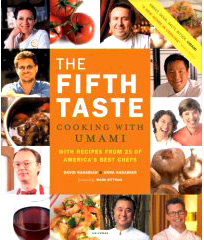 With so many salts and so little time, we predict the coming of a “salt of the month” approach at fine dining establishments: “Good evening madame. This month’s salt is Anglesey, harvested from the Atlantic waters that surround the Isle of Anglesey, off the west coast of Wales. Anglesey has a soft, flaky texture. Why not begin your tasting by sprinkling some on the butter with your bread?” With so many salts and so little time, we predict the coming of a “salt of the month” approach at fine dining establishments: “Good evening madame. This month’s salt is Anglesey, harvested from the Atlantic waters that surround the Isle of Anglesey, off the west coast of Wales. Anglesey has a soft, flaky texture. Why not begin your tasting by sprinkling some on the butter with your bread?”
Salt is one of the four or five flavors which human taste buds recognize. You know about sweet, sour, salty and bitter; the fifth flavor, umami or “savoriness,” focuses on a “brothy” taste equating to the taste of the common food flavoring monosodium glutamate, or MSG. A concept considered basic in Japanese and Chinese cuisine, it was recently explained to Westerners in a scientific-yet-entertaining book with great recipes so you can fully understand the concept: The Fifth Taste: Cooking with Umami, by Anna Kasabian and David Kasabian (photo above). Click here to read more about the book. You’ll learn to recognize umami not only in fermented Asian foods such as soy sauce, fish sauce, miso and black bean sauce; but in some vegetables, soup stocks, anchovies, parmesan and Roquefort cheeses, tomatoes, (including tomato sauce and ketchup), walnuts, grapes, broccoli, mushrooms, and to a lesser degree in meat (although sometimes the umami flavor is referred to as “meaty”). Here are a few types of salt; for a more elaborate selection, see our Salt Glossary.
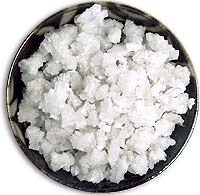 Sea Salt (also called sal del mar [Portuguese], sel de mer [French], and sale marino [Italian]). Sea salt is a broad term that refers to unrefined salt derived directly from a living ocean or sea. It is harvested by channeling ocean water into large, shallow clay trays or other receptacles and allowing the sun and wind to evaporate it naturally. The finest artisan salts are natural or organic and are not treated or washed. Even lesser-grade sea salts are typically not refined as much as other kinds of salt, so they still contain traces of other minerals, including iron, magnesium, calcium, potassium, manganese, zinc and iodine. While all table salts are sodium chloride, there is a night-and-day difference between the flavor of sea salts, which are an artisan product, and common table salt. Because different bodies of water have different mineral contents, salts will look and taste different: some have flowery nuances, some are strong, some delicate, some have sulfuric notes, some can taste sweet, et al. For the convenience of chefs and consumers, sea salt is produced in coarse, fine and extra fine grain sizes. Since there are different qualities of sea salt, for a finishing salt or garnish, buy the best. A little lasts a long time, and you’ll taste the difference. Sea Salt (also called sal del mar [Portuguese], sel de mer [French], and sale marino [Italian]). Sea salt is a broad term that refers to unrefined salt derived directly from a living ocean or sea. It is harvested by channeling ocean water into large, shallow clay trays or other receptacles and allowing the sun and wind to evaporate it naturally. The finest artisan salts are natural or organic and are not treated or washed. Even lesser-grade sea salts are typically not refined as much as other kinds of salt, so they still contain traces of other minerals, including iron, magnesium, calcium, potassium, manganese, zinc and iodine. While all table salts are sodium chloride, there is a night-and-day difference between the flavor of sea salts, which are an artisan product, and common table salt. Because different bodies of water have different mineral contents, salts will look and taste different: some have flowery nuances, some are strong, some delicate, some have sulfuric notes, some can taste sweet, et al. For the convenience of chefs and consumers, sea salt is produced in coarse, fine and extra fine grain sizes. Since there are different qualities of sea salt, for a finishing salt or garnish, buy the best. A little lasts a long time, and you’ll taste the difference. 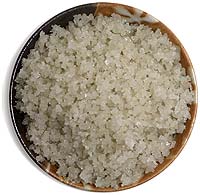 Grey Sea Salt (also called grey salt, Celtic sea salt and sel gris [French]). Grey sea salt is a “moist,” unrefined sea salt harvested along the coastal areas of France. Its light grey color sometimes has a purplish hue, depending on the amount of clay found in the salt flats. One of the most famous salt ponds, in the salt marshes around the town of Guérande in Brittany, France, is lined with natural clay and produces very grey salts. The clay contributes valuable minerals and nutrients that add to both the nutritional value and flavor of the salts. Grey salt is collected by hand with wooden rakes by artisan paludiers (salt harvesters or salt rakers) who sweep the top of the evaporating sea water (this is an ancient Celtic method which earns the salt its name). For centuries a mainstay of French cooking, grey salt has gained great popularity in the mainstream culinary world over the last few years and is considered by many to be the best quality salt available. Fleur de Sel is a particular kind of grey salt. Grey Sea Salt (also called grey salt, Celtic sea salt and sel gris [French]). Grey sea salt is a “moist,” unrefined sea salt harvested along the coastal areas of France. Its light grey color sometimes has a purplish hue, depending on the amount of clay found in the salt flats. One of the most famous salt ponds, in the salt marshes around the town of Guérande in Brittany, France, is lined with natural clay and produces very grey salts. The clay contributes valuable minerals and nutrients that add to both the nutritional value and flavor of the salts. Grey salt is collected by hand with wooden rakes by artisan paludiers (salt harvesters or salt rakers) who sweep the top of the evaporating sea water (this is an ancient Celtic method which earns the salt its name). For centuries a mainstay of French cooking, grey salt has gained great popularity in the mainstream culinary world over the last few years and is considered by many to be the best quality salt available. Fleur de Sel is a particular kind of grey salt. 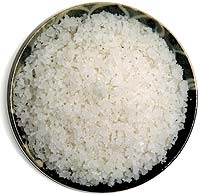 Fleur de Sel (also called flower of salt, flor de sal [Portuguese]). The name comes from the aroma of violets that develops as the salt dries. Perhaps the best known artisan sea salt, it is comprised of “young” crystals that form naturally on the surface of salt evaporation ponds—only the premium, top layer of the salt bed is used. French Fleur de Sel is hand-harvested by paludiers under specific weather conditions, on especially warm days that abet the evaporation of the salt crust on the surface of the salt pool. It is choice, less salty and more delicate than sel gris as a whole. Like wine regions, different areas produce salts with their own unique flavor and aroma profiles. The Guérande region of Brittany, which produces grey sea salt, produces a fine Fleur de Sel de Guérande. Fleur de Sel de Camargue, from the Mediterranean salt marshes of Camargue in Provence, is also highly respected. Fleur de Sel is the favorite of many chefs to season salads, cooked fresh vegetables and grilled meats; as well as for chocolates and other dessert applications. Fleur de Sel (also called flower of salt, flor de sal [Portuguese]). The name comes from the aroma of violets that develops as the salt dries. Perhaps the best known artisan sea salt, it is comprised of “young” crystals that form naturally on the surface of salt evaporation ponds—only the premium, top layer of the salt bed is used. French Fleur de Sel is hand-harvested by paludiers under specific weather conditions, on especially warm days that abet the evaporation of the salt crust on the surface of the salt pool. It is choice, less salty and more delicate than sel gris as a whole. Like wine regions, different areas produce salts with their own unique flavor and aroma profiles. The Guérande region of Brittany, which produces grey sea salt, produces a fine Fleur de Sel de Guérande. Fleur de Sel de Camargue, from the Mediterranean salt marshes of Camargue in Provence, is also highly respected. Fleur de Sel is the favorite of many chefs to season salads, cooked fresh vegetables and grilled meats; as well as for chocolates and other dessert applications.
The photos above are courtesy of Saltworks, which sells these and other fine salts.
For more information about salt, see the Salt Glossary in THE NIBBLE online magazine.
Favorite Salts From Around The World
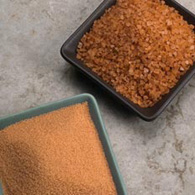 |
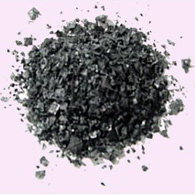 |
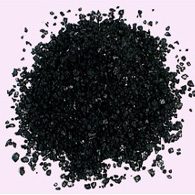 |
Alaea Hawaiian Sea Salt. Alaea is the traditional Hawaiian table salt used to season and preserve. It is rich in trace minerals, all of which are found in sea water. A small amount of harvested reddish Hawaiian clay (alaea) enriches the salt with iron-oxide. 7 ounces. Click here to purchase or for more information. |
Black Cyprus Flake Sea Salt. A distinctive, flaky pyramid-shaped salt that stimulates the imagination. Garnish hors d’oeuvres; chicken and veal; white fish, arctic char and other seafood; tomatoes and other vegetables; eggs and much more. The beauty and drama of the salt as well as the delicate flavor makes an everyday dish into a gourmet presentation. Click here to purchase or for more information.
|
Hawaiian Black Lava Sea Salt. Although less well known than the traditional red alaea salt, hawaiian black sea salt, or lava salt, is a dramatic, glossy black sea salt with a sulfur nose. The unique color comes from lava, which adds minerals and activated charcoal, resulting in a sulfuric aroma. Delicious on all seafoods; use as a finishing salt. Like the red salt, a dramatic garnish and plate decor. Click here to purchase or for more information. |
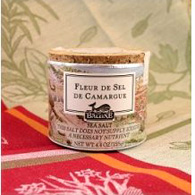 |
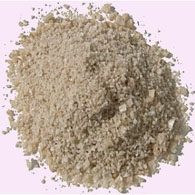 |
|
Fleur de Sel de Camargue. Hand gathered from the Mediterranean salt marshes in the Camargue region of Provence, France and carefully dried without processing or refining, this sea salt is a favorite of connoisseurs around the world. The container has a cork top and is labeled with the salt harvester’s name (as each harvest is considered a unique art form). Fleur de Sel is wonderful atop meats, potatoes and poultry; sprinkle it atop your favorite foods just prior to serving. Click here to purchase or for more information. |
Smoked Fleur de Sel. It’s rare to find a naturally smoked Fleur de Sel de Guérande. After harvesting, the salt is smoked over the wood of select French oak wine barrels that were used to age French chardonnay wine. During smoking, the Fleur de Sel turns a pale brown and absorbs the complex flavor combination of smoke, oak and chardonnay. An exceptional finishing salt for meats, seafood, pasta, salads and eggs. Click here to purchase or for more information. |
|
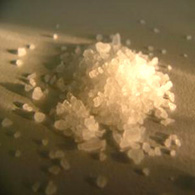 |
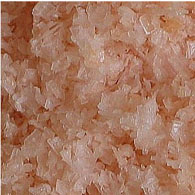 |
|
Maldon Sea Salt. From the banks of the River Blackwater in Essex, England, Maldon is known for its pyramid-shaped crystals, soft texture and delicate, clean taste. It is the ideal complement to meat in flavor and in forming the desirable crust on seared cuts. Maldon often wins taste tests over Fleur de Sel and other sea salts. When it won in a Cook’s Illustrated test, “Tasters loved the crunch of the large sea-salt flakes or crystals when sprinkled over slices of roast tenderloin.” Click here to purchase or for more information. |
Murray River Pink Flake Sea Salt. This pink flake salt is from the Murray River, the largest river in Australia. It empties into the Murray Darling Basin, where low rainfall leads to a high concentration of salinity. The delicate flakes dissolve quickly on food. As a finishing salt, it is well suited for beef and game. Click here to purchase or for more information. |
|
|
More Favorite Chocolate Books
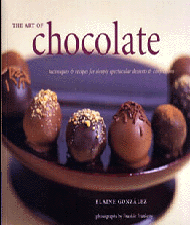 |
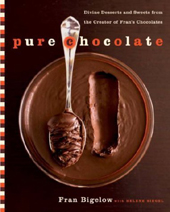 |
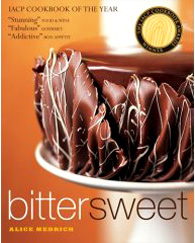 |
| The Art of Chocolate: Techniques and Recipes for Simply Spectacular Desserts and Confections, by Elaine Gonzalez and Frankie Franken. An extravagant paean to decadent desserts, this definitive guide to working with chocolate is unusual because it is written with beginners in mind. Innovative techniques put the art of working with chocolate within everyone’s reach: after mastering a few basics, anyone can create shimmering cakes, seductive truffles and incredible chocolate sculptures. Click here to purchase or for more information. |
Pure Chocolate: Divine Desserts and Sweets from the Creator of Fran’s Chocolates, by Fran Bigelow and Helene Siegel. The award-winning Seattle chocolatier shares recipes and basic rules of working with chocolate, then proceeds to act like a best friend and coach in each and every recipe. The experienced baker and chocolatier may jump right in. For the newcomer, Fran suggests those recipes that are easiest to master and act as building blocks for more complex procedures. Your results, in other words, are guaranteed. Click here to purchase or for more information. |
Bittersweet : Recipes and Tales from a Life in Chocolate, by Alice Medrich. Medrich founded the famous dessert shop Cocolat in Berkeley in 1976 and includes some of her legendary recipes in this book, made practically foolproof thanks to her added “chocolate notes.” Medrich provides equivalencies which allow you to use your favorite chocolate and tweak the recipe to make it work. There are savory recipes too, such as Roasted Squash Soup with Cocoa Bean Cream. Click here to purchase or for more information. |
FOR ADDITIONAL INFORMATION, special offers, contests, opinion surveys, THE NIBBLE back issues archive, product gift-finder, links to our favorite food websites, and the ability to nominate YOUR favorite nibbles, visit the home page of TheNibble.com.
Do you have friends who would enjoy THE NIBBLE?
Click here to send them an invitation to sign up for their own copy. |
ABOUT THE NIBBLE. THE NIBBLE, Great Food Finds, is an online magazine about specialty foods and the gourmet life. It is the only consumer publication and website that focuses on reviewing the best specialty foods and beverages, in every category. The magazine also covers tabletop items, gourmet housewares, and other areas of interest to people who love fine food.
© Copyright 2004-2025
Lifestyle Direct, Inc. All rights
reserved. All information contained herein is subject to change at any time
without notice. All details must be directly confirmed with manufacturers, service
establishments and other third parties. The material in this newsletter may not
be reproduced, distributed, transmitted, cached, or otherwise used, except with
the prior written permission of Lifestyle Direct, Inc.
|
 |
|
 |